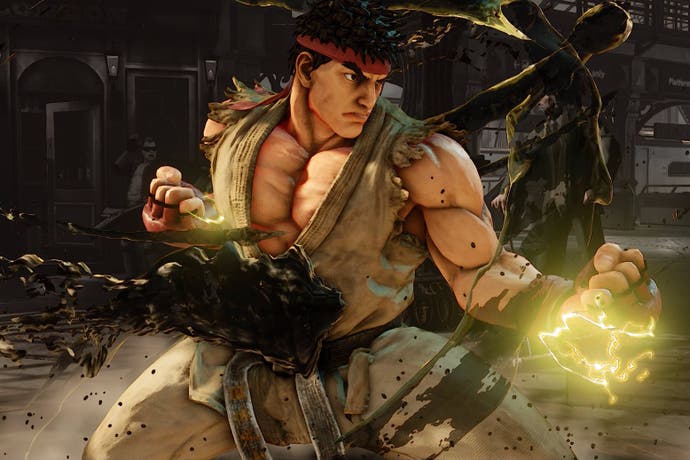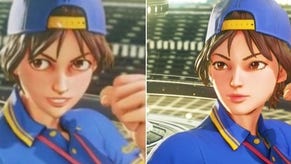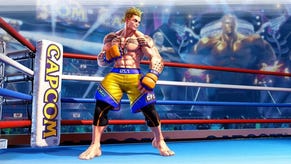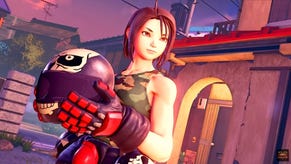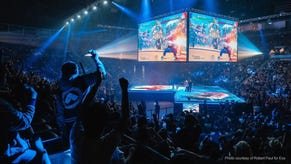Street Fighter 5 ditches Focus for V-Triggers
Parries! Reversals! Critical Arts! More!
Street Fighter 5, the next game in Capcom's brilliant fighting game series, is more evolution than revolution, but when it comes down to mechanics, important changes have been made.
Street Fighter 4's Focus Attack, which let players absorb enemy attacks before unleashing a counter-attack of their own, has been ditched for Street Fighter 5, due out in 2016 for PlayStation 4 and PC.
In their place are V-Triggers, which you perform by pressing HP + HK - and they work differently for each character.
During a recent hands-on opportunity in London, I got to play with four Street Fighter 5 characters in a new build of the game: Street Fighter favourites Ryu, Chun-Li and M. Bison, and back from the dead soldier Charlie Nash. Each character's V-Trigger move works in a significantly different way, and they're each particularly useful. Take Ryu's, for example. His sees him enter a powered up state from which he can do extra damage and guard break. Chun-Li's V-Trigger gives her attacks extra hits. Charlie has a teleport. And M. Bison gets improved movement and new combos. You can't just spam these V-Trigger moves, however. You need a full V-Gauge to use them, and you build V-Gauge by taking damage.
V stands for Variable and, clearly, that's the theme for Street Fighter 5's new battle system. The V-Gauge gives each character even more options than Street Fighter 4's Revenge meter did. V-Reversals work like the Alpha Counters from the Street Fighter Alpha series. You need one bar of V-Gauge to use a V-Reversal, and they're tricky to pull off, as you need to time the input command (forward + all three punches) to coincide with when your guard blocks your opponent's attack, but they're pretty powerful. A V-Reversal will automatically wave away an enemy attack and see you strike your opponent - perfect for getting out of sticky situations and beat down combos.

Elsewhere, each character has a V-Skill move (MP + MK), which is a defensive option that, again, works differently for each character. Unlike the V-Trigger and V-Reversal abilities, V-Skill does not require any meter to use, so you can use it freely.
Ryu's V-Skill will be of particular interest to Street Fighter 3 fans - it's a parry. Playing as Ryu in Street Fighter 5 and using his V-Skill to parry attack after attack rekindles memories of the greatest moment in competitive Street Fighter history: Daigo's dramatic comeback against Justin Wong.
Nash's V-Skill is pretty useful, too: he can absorb a projectile, letting him build V-Gauge quickly. It's sort of like a Focus Attack. M. Bison's V-Skill takes this idea one step further: he grabs a projectile and chucks it back.
There are more than a few nods to previous Street Fighter games in Street Fighter 5. I've already mentioned how V-Reversals work like Alpha Counters, and Ryu's V-Skill is a Street Fighter 3-esque parry, but the references don't stop there.
Street Fighter 5's Ultra Combos have been replaced with Critical Arts, whose name is a nod to the Super Arts from Street Fighter 3. However, to use one you need a full EX meter (your EX meter works the same in 5 as it did in 4). In the build I played, each character had one Critical Art available: Ryu's Shinku Hadouken is a charged up fireball, Chun-Li's Hoyokusen is a blur of kicks, M. Bison's Ultimate Psycho Crusher is a close quarters shove, and Charlie's Judgement Saber is a sneaky Sonic Boom backstab. They're particularly powerful, dealing a tonne of damage, as you'd expect.
While I'm sad to see Street Fighter 4's Focus attack fall by the wayside, the new V-Gauge and the abilities that are tied to it give you more options and, hopefully in the long term, more varied play. Charlie's teleport is a great example of this. There are three versions, triggered by pressing different directions in combination with HP + HK. It gives him a great mix up potential and, in combination with the Sonic Boom special move, the option to hit his opponent from the front and the back. Ryu, too, has more tools at his disposal in 5 than he does in 4. His V-Trigger gives him guard break, as already mentioned, but it also opens up an alternative Critical Art, the Denjin Hadoken.
You might say V-Triggers are as close to stance changes as Street Fighter 5 has. I admit, this is a clumsy comparison, but for some characters it's apt. M. Bison, for example, by default moves incredibly slowly in 5. With his arms folded he strolls back and forth as slow as a snail, which, at first glance, makes him feel almost useless (this isn't helped by the fact his useful Psycho Crusher is now a Critical Art, not a special move).
But his V-Trigger gives him better movement and new combos, changing the way he plays significantly. His dash becomes a teleport, so he's able to pass through projectiles and attacks, and he also disappears and reappears during his Somersault Skull Diver and Double Knee Press attacks, making them extremely hard to track. (As an interesting aside, M. Bison is the only character I've seen with a three-bar V-Gauge, indicating he'll get more V-Reversal bang for his buck than the other characters.)
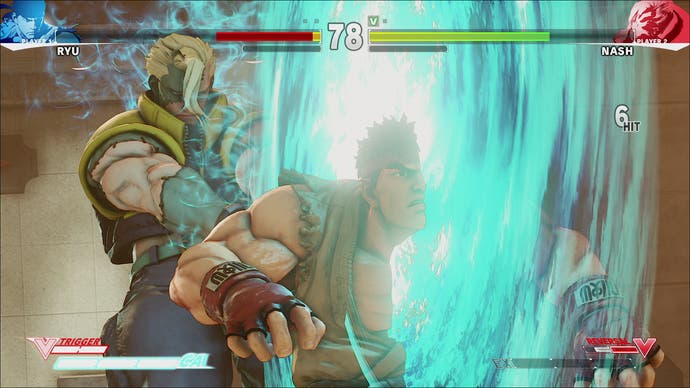
Complimenting this more considered movement is a real weight to attacks. Land a hit in Street Fighter 5 and you really feel it. The game's punches and kicks are as meaty and satisfying to land as any fighting game I've played. You get a real sense of power, of impact and affect. The audio comes into its own, here, with characters yelling with each thrust and parry, and the hyper-stylised visuals do their part, too. Remember Ryu's Metsu Shoryuken Ultra Combo in Street Fighter 4? The one where each punch lands on his opponent's face like a truck slamming into a wall? It's a bit like that.
Street Fighter 5 takes Street Fighter 4's beefy, vibrant cartoony graphics and refines, rather than revolutionises the visuals. The jump to PS4 means there are fancier and more elaborate effects on-screen, there's an increased sense of depth to the arenas and the lighting has taken a definite step up. I've also noticed the thick, black lines of Street Fighter 4 appear to have been softened. Perhaps Capcom's going for a less cartoony, more fancy painting look this time around. Either way, the leap from Street Fighter 4 to 5 is nowhere near as pronounced as the jump from Third Strike to 4 was, which is perhaps an inevitable consequence of the shortened gap between releases (4 came out a whopping nine years after 3rd Strike. 5 arrives a year after Ultra Street Fighter 4 on PS4).
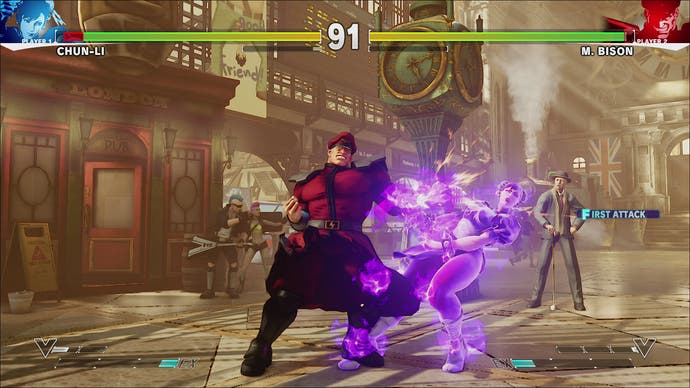
At least Capcom has lost none of its trademark playfulness when it comes to making stereotypical levels. One of the new arenas is based on London's King's Cross station, and its looks like it was drawn from a tourist's guidebook. You'll spot a Bearskin hat-wearing brass band, a red telephone box, a dancing chap who wears a bowler hat and holds a croquet mallet, a steam train, a punk rocker and the wonderfully named "London Pub" all peering out of the background. It's all a bit open top bus tour, but then, aren't all Street Fighter stages?
While I was playing Street Fighter 5 I wondered whether it even needed to exist. Capcom's pumped out a dozen or so versions of Street Fighter 4 - for me the greatest fighting game ever made - since 2008, the latest of which came out only last month on PS4, so it's not like I'm salivating for more Street Fighter or waiting for the series to turn up on the latest console. But what this is really about is Street Fighter 5 is yet to spark into life. It's already a fun fighting game, but it's yet to grab me by the scruff of my neck and scream: IT'S HAPPENING.
I'm sure it will, eventually. The road to release is long and packed with new character reveales. Until then, Street Fighter 5 is a case of good, but not yet great.
